Decisive phase in path towards eradicating terrorism, achieving
peace
Govt takes bold stand on withdrawing from Ceasefire
which Tigers openly violated thousands of times:
The dawn of 2008, brought the country into a decisive phase in its
three decades long efforts to see an end to LTTE terrorism. The common
masses of the country witnessed the bloody face of the conflict as they
were about to breath fresh air in 2008 with renewed hopes as the news
about the assassination of UNP Colombo District Parliamentarian T.
Maheshwaran hit the country.

Prime Minister Ranil Wickremesinghe hands over CFA document to
then Norwegian Ambassador Jon Westborg |
Police are still conducting investigations which has many
complexities due to the diverse links the slain MP had in the business
sector as a business tycoon and in politics.
Again on Wednesday the country witnessed yet another bomb blast in
the heart of Colombo just hundred metres away from the vital security
installations, the Army Headquarters and the Air Force Headquarters.
The target of the claymore was an Army bus transporting patients to
the Narahenpita military hospital.
Again it was yet another attempt by the LTTE to destabilise the South
to jeopardise the efforts of the Security Forces who are now on a
victorious path towards the Wanni.
However, the most vital and much expected news about the decisive
phase of the country’s three decades long conflict came on Wednesday
night following the Cabinet meeting.
There were many indications that Government was waiting to officially
withdraw from the Ceasefire considering the number of violations taking
place at a stretch.
Defence Secretary Gotabhaya Rajapaksa last Friday gave first signal
about the Government’s decision to officially withdraw from the
Ceasefire in an exclusive interview with this correspondent saying that
President can have a fresh start once he officially abrogates the
Ceasefire Agreement and bans the LTTE.
|
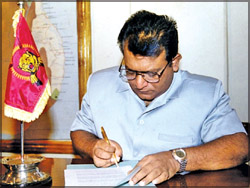
V. Prabhakaran signs CFA |
One phase of his statement was implemented on Wednesday with the
Cabinet unanimously agreeing to a memorandum moved by Prime Minister
Ratnasiri Wickremanayaka to officially withdraw from the Ceasefire
Agreement.
The Premier was entrusted to proceed with the legal procedure to
notify the Norwegian facilitators about Government’s decision to
withdraw from the Ceasefire Agreement.
Therefore this can be considered as the first instance in post
independence Sri Lanka where any Government took a decision to
officially withdraw from the Ceasefire Agreement entered with the LTTE.
Many Ceasefire Agreements have been signed with the LTTE and they have
been abandoned or just ignored as invalid documents without abrogating
them officially.
But it should not be the way for any legitimate Government to act.
Legitimate Governments should stand by the agreement they have reached
with other parties and should withdraw from it officially if they cannot
adhere to it properly.
The LTTE leader Velupillai Prabhakaran as leader of a ruthless terror
outfit can opt to say one and do another. But legitimate Governments
cannot act irresponsibly.
Therefore, the Government should be commended for taking one stance
without taking a duplicitous position about the future of the country,
though it is a common practice of Tiger leader Prabhakaran to declare
his commitment to peace and wage war on the other hand.
Though politicians who entered into this so-called Ceasefire
Agreement with the LTTE with short sighted policies kept a blind eye on
what the LTTE was doing in the North East, Government with genuine
concerns for the country cannot continue with it for long.
|
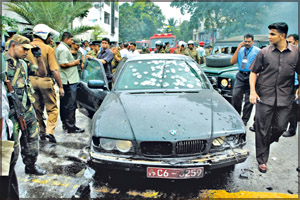
Attempt on life of Defence Secretary |
|
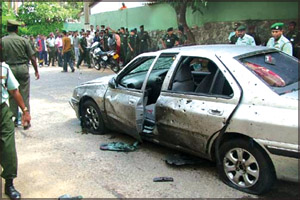
Attempt on the life of Army Commander |
|
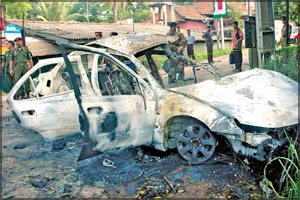
Maj. Gen. Parami Kulatunga was killed by LTTE |
It was quite apparent that the LTTE entered into this Ceasefire
Agreement in 2002 as they were facing hard times in the Wanni at the
hand of troops engaged in Long Range Reconnaissance Missions and also
due to bad environment prevailed internationally for terror
organisations after the 9/11 attack in the United States.
The Security Forces now have clear proof that Tiger leader Velupillai
Prabhakaran was not genuine in his effort to pursue a peaceful
resolution to the problem, though he signed the Ceasefire Agreement with
then Prime Minister Ranil Wickremesinghe.
The Ceasefire was only a cover up for their terror operation to
achieve his day dream the Tamil Eelam as he told a gathering of leaders
immediately after the signing of the Ceasefire Agreement.
A lot of water has flowed under the bridge during almost six years
period in which the Ceasefire was in effect. The first lot to sacrifice
their lives for the sake of CFA was the intelligence operatives and
political opponents of the LTTE.
Many intelligence operatives working for the Security Forces were
gunned down in broad daylight while the then Government was turning a
deaf year for the protests of the public against the LTTE.
Lt. Col. T.N. Muthaliff who was killed in Narahenpita on May 30, 2005
and Lt. Colonel. T.R. Meedin who was killed in Kiribathgoda on October
30, 2005 were the highest ranking intelligence officers killed by the
LTTE under the cover of the CFA.
Then it was the political opponents of the LTTE who paid their lives
on behalf of the Ceasefire Agreement. Hundreds of EPDP members were
killed by the LTTE in broad daylight with no perpetrators brought to
book by the relevant authorities.
The so-called truce monitors from the Nordic countries were rendered
helpless when these incidents were taking place.
The LTTE totally disregarded the protests made against the killing of
intelligence operatives at the six rounds of peace talks held thrice in
Thailand and in Japan, Germany and Norway.
The six rounds of talks merely became a stage drama where the two
sides shook hands before the media but achieving nothing at the end.
Finally, the Ceasefire Agreement became a unilateral one with only
Security Forces adhering to it while LTTE was engaged in gun running
under the pretext of the Ceasefire.
The Security Forces had to observe silently the way the LTTE was
transporting military hardware and vital communications equipment
through Security Forces road blocks and when LTTE openly invaded the
territories coming under the Government for their military build up.
According to the military, the LTTE increased their firepower 20
times compared to what they had before the signing of the Ceasefire
Agreement and their manpower by ten folds with the recruitment drive
they carried out even in cleared areas.
Then Defence Minister Tilak Marapana had to admit the fact that there
was a LTTE build up surrounding the Trincomalee
|
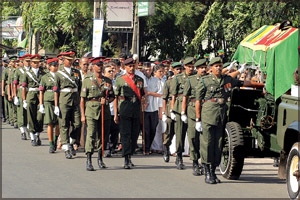
Funeral of Lt. Col. Muthalif |
harbour when the late
Lakshman Kadirgamar as a Member of the Opposition questioned the
Government about the security situation in the country.
But nothing was done to redress the security concerns of the country
until President Chandrika Kumaratunga took over the Defence Ministry and
the Media Ministry under her preview.
Those who opposed the LTTE opinion were brutally assassinated by the
LTTE with no one raising a hand against them.
Prabhakaran openly hunted down Karuna cadres when Karuna Amman the
Eastern leader of the LTTE defected from the Tiger outfit.
Even the former Foreign Minister Lakshman Kadirgamar had to sacrifice
his life for his life long battle against LTTE terrorism on August 15,
2005. This was the most serious CFA violation by the LTTE, even at a
time he was speaking in favour of the Interim Administration Structure
to be offered to the LTTE for Tsunami reconstruction.
But those incidents were ignored for the sake of peace, but nobody
saw any light at the end of the tunnel.
It was under the Mahinda Rajapaksa administration that the LTTE
re-entered peace negotiations on February 22, 2006 as the country marked
the fourth anniversary of the Ceasefire Agreement.
But they were all made futile attempts as the LTTE continued the path
of violence against the Security Forces in the North East killing more
than 264 Security Forces personnel in their claymore attacks.
|
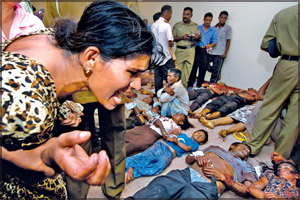 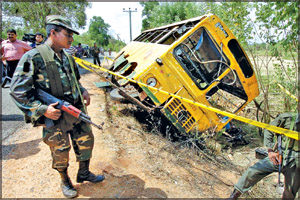
Victims of the Kebithigollewa bus blast |
The attempt to take the life of Army Commander Lt. General Sarath
Fonseka and Defence Secretary Gotabhaya Rajapaksa were major highlights
among the Ceasefire violations committed by the LTTE. Though Lt. General
Sarath Fonseka and Gotabhaya Rajapaksa were fortunate enough to survive
suicide blasts Major General Paramee Kulatunga finally made the supreme
sacrifice at the hands of a suicide bomber of the LTTE on June 26,2006.
It was after the assassination attempt on Army Commander Lt. General
Sarath Fonseka on April 25, 2005 the Security Forces for the first time
directed their guns on the LTTE side at 5.05 pm on the same day as a
deterrent measure.
The same procedure was followed after the massacre of 64 civilians in
a claymore mine attack on a bus plying on Kebithigollewa Medawachchiya
road on June 15, 2006.
However, the escalated violence of the LTTE then led to a full scale
war after Mavil Aru battle and after the LTTE attempt to capture Muttur
and a subsequent attempt to capture Jaffna peninsula on August 11, 2006.
The subsequent battles were not in favour of the LTTE and the
Security Forces were able to fully clear the Eastern province with the
capture of Sampur, Eethalampattu, Vakarai, Kathirveli, West and South of
Batticaloa and at last Thoppigala in September 2007.
Therefore, the clear policy adopted by the Government not to
compromise national security in perusing peace proved to be a successful
one for the Security Forces as they were able to clear Tiger threats
from the East and also to protect the Jaffna peninsula.
Amid an escalation of fighting, the Government has finally taken the
decision to withdraw from the Ceasefire Agreement.
The only negative factor is that the LTTE can continue international
campaign against the Government for taking first initiative to withdraw
from the Ceasefire.
But it should not be forgotten that the Tiger leader Prabhakaran made
statements twice to the effect that the CFA was almost an invalid
document, though it did not officially withdrew from the CFA.
Under these circumstances the international pressure might be high on
the Government in its effort of eradicating LTTE terrorism from the Sri
Lankan soil.
Since Security Forces have already committed themselves and are fully
prepared for this task they will be able to continue on this path
without succumbing to pressure from the international community.
On the other hand the opportunistic political parties which are
trying to topple the Government would take the maximum opportunity to
highlight whatever mistakes done by the Government and the Security
Forces to bring the situation in their favour and put blame on the
Government for withdrawing from the Ceasefire Agreement.
Things would be much difficult as the LTTE is expected to raise its
ugly head in other parts of the country by exploding bombs and engaging
in violent activities to destabilise the situation.
So it is rather a risky task ahead of the Government in its endeavour
of eradicating terrorism after withdrawing from the Ceasefire Agreement.
But, it is better to stick to one policy rather than adopting two
policies for solving the national question.
It is now clear that the Security Forces are now heading towards
achieving the goal set by the Government to defeat the LTTE fully in the
North East with the intention of clearing the path for implementing a
political solution to address the genuine grievances of the Tamil
community.
So an almost new chapter has been turned in the three decades long
efforts of eradicating terrorism after closing an almost six year long
chapter on the Ceasefire which brought nothing but uncertainty to the
country. |

